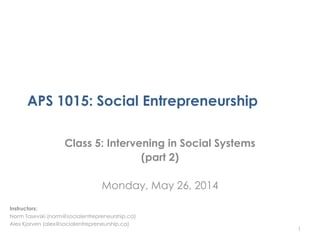
APS1015 Class 5 - Intervening in Systems Part 2
- 1. APS 1015: Social Entrepreneurship Class 5: Intervening in Social Systems (part 2) Monday, May 26, 2014 1 Instructors: Norm Tasevski (norm@socialentrepreneurship.ca) Alex Kjorven (alex@socialentrepreneurship.ca)
- 2. © Norm Tasevski Agenda • Recap of Empathy Mapping & Business Modelling(last class) • Building an Intervention – Step 3: Financial Modeling – Step 4: Target Setting • Prep for Monday 2
- 3. © Norm Tasevski Intervening – A 4 Step Process 3 Step 1: Empathy Mapping Step 2: Business Modeling Step 3: Financial Modelling Step 4: Target Setting
- 4. © Norm Tasevski • For our purposes, this is a process for determining whether business model generates a viable margin • Who determines viability? • The Steps: – Assess revenue model (# units, unit price) – Assess expense model (fixed, variable) – Generate margin 4 Financial Modeling
- 5. © Norm Tasevski • Step 1: Assess Revenue Model – 2 parts: # units sold and price/unit – How do we define a “unit”? • The value proposition perceived as having value by the customer, and to which the customer is willing to pay a price – The relationship between units and price: • The more “custom” a unit, the fewer that can be offered and the costlier the unit is to make. The product is perceived as more valuable, and therefore price is higher • The more “commoditized” a unit, the more that can be offered and the cheaper the unit is to make. The product is perceived as less valuable, and therefore price is lower – How do we determine price? • This is…complicated 5 Financial Modeling
- 6. © Norm Tasevski Financial Modeling – Determining Price 6 Determine cost + desired margin (see step 2) Ask people!!! (friends, potential customers, etc)
- 7. © Norm Tasevski • Step 2: Determine Cost Model – 2 parts: fixed costs, variable costs • Fixed: – The costs that don’t change as more units are sold – Example: rent – Goal: determine the total fixed costs incurred • Variable: – The costs that do change as more units are sold – Example: raw materials used to build the product – Goal: determine the per unit fixed costs incurred • A note: all fixed costs are variable over time! 7 Financial Modeling
- 8. © Norm Tasevski 8 Your Best Friend…
- 9. Break 9
- 10. © Norm Tasevski • The key business and social metrics used to execute the business model in a way that aligns with the financial model • Business targets: – Revenue targets (e.g. # units sold in the quarter) – Expense targets (e.g. target marketing budget) • Social targets: – “Output” targets (e.g. # people employed) – “Outcome” targets (e.g. increase in community resiliency) • SMART 10 Target Setting
- 11. © Norm Tasevski • Baseline vs. Target – Baseline: your starting point – the reference metrics – Target: the measurable improvement from the baseline • Linking targets to the business model – Each element of the canvas deserves their own metrics (e.g. target # customers, target #/type of activities to run) 11 Target Setting
- 12. © Norm Tasevski What did we learn? 12
Hinweis der Redaktion
- NORMFocus on the distinction between entrepreneur and enterprise